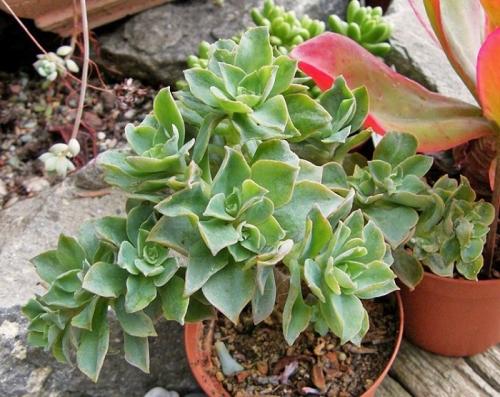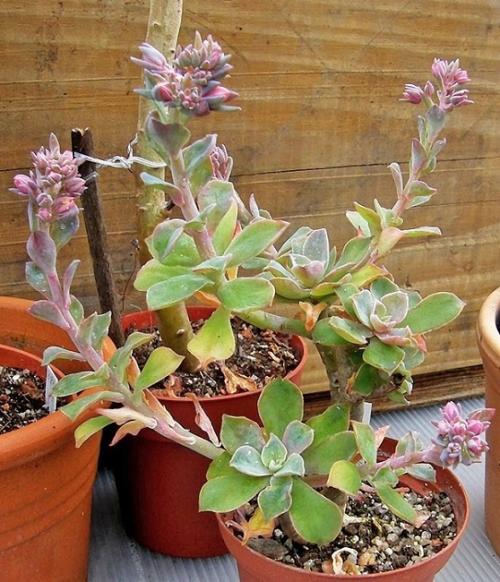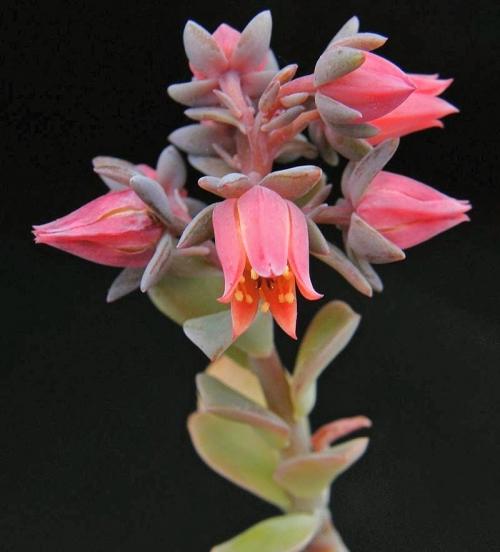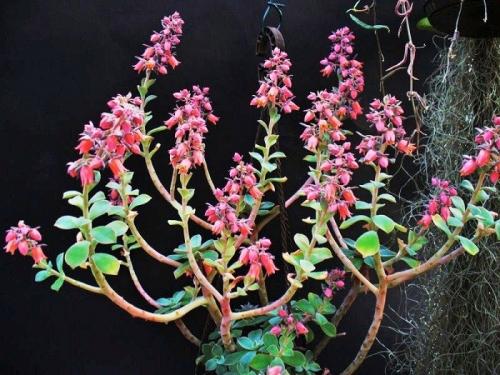AUSTRALIS Rose, 1903
Series Nudae
Lectotype : Pittier s.n., Rose 523, Prov. San José, Costa Rica (US 397557).
Etymology : Latin adjective australis = southern - for the relatively southern distribution in relation to the bulk of the genus.
Distribution : Costa Rica (Prov. San José & Cartago); Panama (Prov. Chiriqui) ; mostly epiphytic. See Notes below.
First Description by Rose, in Britton & Rose, Bulletin of the New York Botanical Garden 3(9): 6-7.1903 :
Caulescent, 20 - 30 cm long, or 50 - 60 cm including the inflorescence, glaucous.
Leaves broadly spatulate, rounded at apex, 3 - 7 cm long, sometimes 3 cm broad and spoon-shaped, somewhat glaucous and often purplish, thickly set at apex of branches, early falling off below.
Flowering branches stout, bearing numerous large oblong bract-like leaves, inflorescence an elongated equilateral raceme or somtimes more compound, forming a narrow panicle, pedicels 1 cm long or less, slender.
Flowers : Buds strongly 5-angled, acute, sepals unequal, the longer ones 12 mm long, ovate-oblong, purplish, glaucous, nearly or quite free to the base, petals bright red, thickish, a little longer than the longest sepals, nearly distinct, cup-shaped at base, stamens 10, the 5 opposite the sepals borne on petals about one forth the distance above the base.
Cytology : n = 28
Note :
1. Walther, Echeveria, p. 297, 1972, states that the type locality of E. australis is Volcan Irazu, San José, Costa Rica.
This is wrong. The plants used for the First Description according to Rose were collected by Pittier in the vicinity of San José, inhabiting rocks and stone walls, not on the Volcan Irazu.
2. Walther's re-description of E. australis (Echeveria, 297-299, 1972) is made "from locally cultivated material" - that means of plants with unknown origin. Therefore it is useless and this applies also to Kimnach's summary in the Crassulaceae volume of the Illustrated Handbook of Succulent Plants, 106, 2003.
3. In view of the fact that in relevant literature E. australis has never been reported from Nicaragua it is astounding how many Nicaraguan Echeveria specimens have been wrongly determined by F.R. Barrie, the author of the treatment of genus Echeveria in Flora Mesoamericana. None of the specimens of Nicaragua to be found online is correctly named ; all of them represent E. pittieri, not E. australis.
Nicaragua Estelí: Cerro Quiabuc, 1485 m, 13°06'50"N 086°25'30"W, 02 February 2010, W. D. Stevens, I. Coronado G. & O. M. Montiel 29385 (HULE, MO) = E. pittieri, not E. australis.
Nicaragua Estelí: Cerro El Bolsón, 1100 - 1200 m, 13°08'00"N 086°27'00"W, 24 January 1981, W. D. Stevens 19022 (MO) = E. pittieri, not E. australis.
Nicaragua Jinotega: 1380 - 1400 m, 13°13'00"N 086°15'00"W, 16 November 1979, W. D. Stevens & Alfredo Grijalva P. 15762 (MO) = E. pittieri, not E. australis.
Nicaragua Madriz: Cerro Buenavista, 1250 - 1300 m, 13°17'00"N 086°36'00"W, 4 enero 1982, P. P. Moreno 14269 (MO) = E. pittieri, not E. australis.
Nicaragua Madriz: Cerro Buenavista, 1300 - 1400 m, 13°18'00"N 086°36'00"W, 4 enero 1982, P. P. Moreno 14319 (MO) = E. pittieri, not E. australis.
P.P. Moreno 8208 = E. pittieri, not E. australis.
R.M. Rueda et al. 12714 = E. pittieri, not E. australis.
Stevens & Montiel 30448 = E. pittieri, not E. australis.
D.A. Neill 115 = E. pittieri, not E. australis.
This is consistent with the lack of reports of E. australis in Nicaragua.
4. E. australis is also not present in Honduras : Herbarium specimens accessible online indicating that E. australis is also occurring in Honduras are wrogly determined - it is E. maxonii which can be found in Honduras, not E. australis.
To summarise :
Missouri Bot. Garden nrs
3761549,
6284537,
2907424,
3036005,
5561416,
3761548,
6310212,
3761550,
2797934,
3761547 and
Stevens & Grijalva 15762 all represent E. pittieri and not E. australis.




